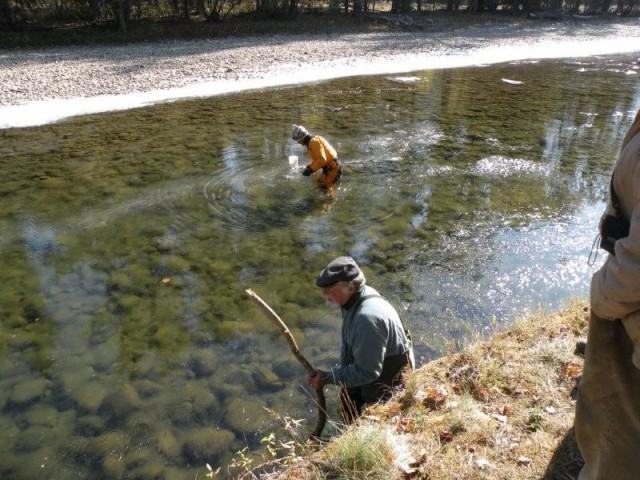Freshwater mussels could be glowing in the Kettle
Radioactive mussels in the Kettle River? A team of concerned environmental groups and researchers say there are. Al Grant of Boundary Alliance and Willy Floyd of the Committee for a Clean Kettle Valley recently conducted a study on the sensitive aquatic species to bring continued awareness to the problems facing the river. Despite some movement in the regional government efforts to start a watershed management plan for the Kettle River, they feel that the continual collection of data is critical to pressure governments to closely examine any new development requests in the Boundary region.
The laboratory results of the tissue sampling done on mussels from two sites – one at Cox’s bridge, Christian Valley and the other Spraggett bridge in Grand Forks – showed bioaccumulation of up to 158 times the average uranium concentrations in the surface waters of the Kettle. These are concentrations up to 9 times greater than the federal drinking water guideline (MAC) of 0.02 milligram/litre (equivalent to parts per million or ppm).
“The interest in the mussels came about because of a comment posted to our online petition by Robert Plotnikoff who used to live in Grand Forks,” said Grant. “I tracked him down because I was interested on the effects of low water levels on the mussels. In looking at some (the information) he sent they talked about the bioaccumulation of substances in mussels. If mussels pick up toxins of one sort or another they would probably pick up uranium. Nothing of the sort had been done in Canada and so it was worth looking at.”
Along with Grant and Floyd, George Floyd, a marine biologist led the sampling process, Mark Grant, bachelor of science in physics and geological engineering completed data recording and Robert Plotnikoff, senior aquatic ecologist with Tetra Tech Surface Water Group in Seattle, WA all provided expertise to the study that was conducted in October. The western pearlshell mussel (margaritifera falcate) are an indicator species for freshwater rivers since each mussel can process up to seven gallons of water a day and process toxins from the water. These toxins in turn accumulate in their tissues.
“Environmental results from tissue analysis of this species at two locations in the Kettle River drainage identify potential problems that may prompt extirpation of the most important species of interior B.C. freshwater life,” said Plotnikoff. “The longevity of the freshwater mussel is greater than the average life span of humans and serves as the most important indicator of the river’s environmental health and protection of the people who enjoy the beauty of the Kettle.”
So what does this mean? Grant suggests that this should be an alert to the region that the potential of new developments which disturb or expose uranium – not only mining but also activities such as road development, excavation, etc. – should be examined closely as part of the regular process. Grant also says it’s critical to get a watershed management plan in place as soon as possible given the with the recent low levels of water in the Kettle river resulting in higher temperatures, problems with fish stocks and the overall health of the river.
“An organism is accumulating one of possible many toxic substances in the Kettle. But while that may not be a great concern to humans, unless they’re making a habit of eating (mussels), it certainly should be an alert as to whether or not we allow any additional sources of uranium to the river. And we should be on guard against it,” said Grant.
The province of B.C. and the federal government are teaming up to provide the resources for a watershed study which will lead to a plan said regional district area E representative Bill Baird. The ministry of agriculture and lands will be proceeding with a modeling process similar to the study conducted in the Okanagan and fisheries will be doing fish stock evaluations. In addition, Baird said that there will be a drought management plan developed by a consultant.
“Its all going to tie into what we are looking for,” said Baird. “We need to know how many users we have, and how much available water we have. This will be an ongoing exercise over three years. We’ve finally got the province at least coming to the table.”
Grant is not so confident that the study is enough. He feels that the governments managing the process are not anxious to have a plan in place regarding the water use on the Kettle.
“The regional district is asking the ministry of environment to be the primary lead when the MOE is one our biggest problems. They are the approvers of water licences, they are the approvers of the licences at Big White (ski resort), and they’re the folks that say any consequences of the Cascade power project is of no worry. I have no confidence in the MOE or the regional district to be leading any process,” said Grant.
For the full report go to: www.boundaryalliance.org/bioreptcombined.pdf
MOE site with water readings: waterquality.ec.gc.ca/waterqualityweb/stationOverview.aspx
Safe drinking water standards:
www.interiorhealth.ca/uploadedFiles/Health_and_Safety/Drinking_Water/Uranium_InfoSheet.pdf






















